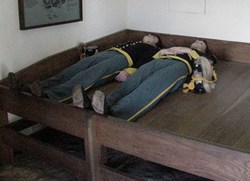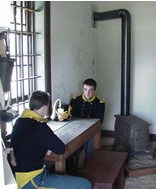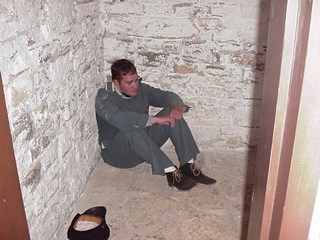|
All soldiers were expected to take their turn at guard duty, which came about every fifth day. When a soldier was assigned to guard duty, he was assigned for twenty-four hours straight. He would generally patrol for two hours then rest for four hours, patrol for two hours, then rest for four hours and so on throughout the twenty-four hour period.

Soldiers never welcomed guard duty. In addition to having to walk a post, guards had to stay awake for twenty-four hours. During the four hour rest period, if the guard wished to lay down and rest, he would have had to do so on a hard platform bed. But he would've had the option of laying down on the bed only during the day. At night, he could neither sleep nor lay down under any circumstances. 
When men of the guard were not absent at sentry posts or on other assignment, they were to remain in the guardroom, fully clothed (including shoes), their weapons close at hand, ready to respond to any call. Sentry assignments were rotated through the twenty-four hour period, and supervised by the corporal. Men might also be detailed as messengers or for special assignments. All took their meals in the guardroom.

The prison section of a typical guardhouse was divided into a common prison room and a few isolation cells for incorrigibles. For the most part, prison facilities received no fixtures other than slop buckets and, often, iron rings in floors or walls to which shackles were secured. Prisoners commonly slept on floors; although, usually, depending upon the sentiments of the local commander or the circumstances of an individual sentence, they took their blankets into jail with them. Prisoners had no sanitary facilities except a bucket to relieve themselves. In the last half of the nineteenth century, post surgeons endeavored to have prison facilities washed, disinfected, and coated with whitewash, but for the most part, guardhouse prison sections were dim, dirty, and dungeon-like. Only enlisted men would have been locked in the guardhouse. An officer in trouble would have been placed under house arrest in his own quarters.
Historic Furnishing Report on The Guardhouse by Sally Johnson Ketcham. |
Last updated: July 25, 2016

